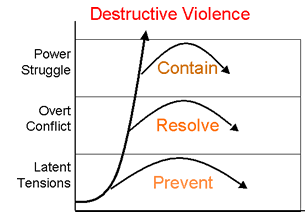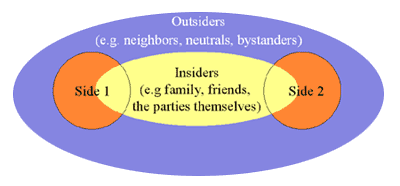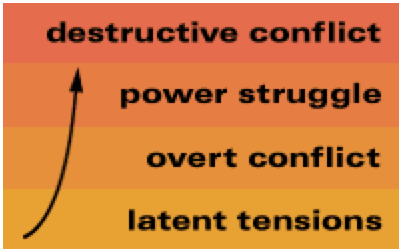The Third Side is everywhere
In the Family
“One night, my mother and her boyfriend got into a silly argument about where they were going to go out,” recounts eighteen-year-old Marquise Johnson, who had been trained as a peer mediator at school in one of Cleveland’s toughest neighborhoods. “I had to sit them down. That was the hardest thing because they just stared at me when I told them to sit down. But I said, ‘I’m going to help you solve this problem – could you sit down, please?’ Afterward, we were all sitting there laughing. I was proud. When I finish college, I want to be a social worker or psychologist.”
Our customs for dealing with domestic problems are beginning to shift away from passivity toward the active intervention of the surrounding community. Abused children and battered spouses are no longer treated, as they traditionally were, just as a “family matter.” Neighbors sound the alarm and social workers, police, and court officers step in. Shelters for battered women offer refuge and counseling.
At the same time, a “yes” to dialogue is beginning voiced. Support groups, marital counseling, and family mediation are becoming much more common and not just among the wealthier classes. Twelve-year-old Jane’s parents were so busy arguing that they forgot about how she felt. “After they had been to mediation,” she recalls, “they listened to each other more, and to me.” “Without family mediation,” her father adds, “I feel we would still be battling it out and spreading the damage over a much wider field.”
More and more divorces begin with an intense effort to settle the economic and child custody issues in a collaborative fashion through mediation – in order to preserve a working relationship between the parties. This can happen even if the children are already grown; as one divorcing wife explained, “We’re going to have to be grandparents together.”
In the Workplace
Torn by interdepartmental rivalries, corporate lawsuits, strikes, employee grievances, and unexpected violence, there are also signs of the Third Side at work. “When my sales representatives create conflicts, they’re often over customers and territories,” says Michael Rosenberg, president of a home food delivery service. He asks the quarreling salespeople to exchange customers or to work as a team. “This way,” he explains, “they’re forced to help each other for the good of the company, rather than worrying about protecting their own turf.”
Thousands of businesses and government agencies have appointed ‘ombudspersons,’ people whose full-time job is to help employees, on a confidential basis, resolve their disputes with management and one another. Once confined to settling union-management contractual disputes, mediation is increasingly being used to resolve employee and customer grievances. Many businesses are also binding themselves in advance to use mediation and arbitration rather than court to resolve their disputes with customers, suppliers, and partners. Of the one thousand largest corporations in America, nearly ninety percent report having used mediation to settle a dispute in order to save money, achieve a more satisfactory agreement, and preserve a good relationship.
Inside many organizations, facilitators are working with cross functional teams to overcome interdepartmental issues. Managers are learning to mediate among their teammates, their employees, and often their multiple bosses. The success of a company is coming to depend on the ability of its people to resolve the innumerable conflicts that crop up between manufacturing and marketing, sales and headquarters, employees and supervisors, and to seek a “triple win” – a solution good for each side and for the company as a whole.
In the Community
In the early 1990s, teenage violence in Boston seemed out of control. There was a shooting every day and a half, a tripling of the rate over the course of ten years. A nine-year-old boy out trick-or-treating on Halloween was killed by gang crossfire as was a teenager walking to an anti-drug meeting. Yet after more than twenty youngsters died a year from firearms in 1992, the rate fell to zero in 1996. The key, according to Boston Police Commissioner Paul Evans was “collaboration.” The entire community was mobilized. The police worked closely with teachers and parents to search out kids who had missed school or whose grades had dropped. Local government agencies and businesses provided troubled youth with counseling, educational programs, and after-school jobs. Social workers visited their homes. Ministers and pastors mentored them and offered a substitute family for kids who almost never had two and sometimes not even one parent at home. Community counselors, often ex-gang members, hung out with gang members and taught them to handle their conflicts with talk, not guns.
Boston is not alone in making good use of the Third Side. All across America, community disputes of all kinds – from barking dogs to landlord-tenant problems to conflicts over children’s toys left on the sidewalk – are increasingly being mediated by trained community volunteers. “I would recommend the process [of mediated negotiation] to any dispute that looks insoluble,” proclaims Judge Clarence Seeliger after mediation resolved an almost-quarter-century-old bitter dispute in Atlanta over the placement of a highway through local neighborhoods. “They [the third parties] probably kept us from pulling out guns and shooting each other across the table,” says Hal Rives, leader of one of the disputing sides. “I don’t think it [the agreement] would have happened without them.”
The young too are learning to mediate. “If we don’t get mediation, I’d fight her,” says Alisha, a sixth-grader at Martin Luther King School. She had asked a fellow pupil, Elizabeth, a simple question, she said, and Elizabeth had responded by calling her names and “getting in my face ugly.” Instead of fighting, however, Alisha and Elizabeth stomped down to the Center for Conflict Resolution on the ground floor of the school to ask for help from a fellow student trained in mediation. “They resolved the problem by agreeing they would try to get along and not get smart with each other,” explained Patrice Culpepper, the eleventh-grader who mediated the case. “There was follow-up afterward, and they were doing fine.”
In more than five thousand schools across America, children are being trained as peer mediators. They do not wait for problems to come to them; they go into the playgrounds and corridors where the problems are. Typically working in pairs, a boy and a girl, the young mediators approach children who are arguing or fighting and ask them if they want to talk it out. Some simple ground rules are stated: Agree not to interrupt, talk about your feelings, agree to look for a solution. The success rate is high. At Melrose Elementary School in Oakland, for instance, the mediation program was credited with substantially reducing violence and cutting suspensions fiftyfold.
This trend of consensual dispute resolution is not limited to the United States. It is occurring around the world, often building on the traditions of mediation indigenous to each society and culture. The Hawaiians have a tradition of ho’oponopono; the Palestinians call it sulha; and the peoples of the Caucasus use their elders as mediators. Spreading from one society to another, learning from local traditions, mediation is becoming a worldwide movement.
In a Warring World
It started as a conversation involving professors and peace activists. Norwegian sociologist Terje Rod Larsen and his wife, Norwegian diplomat Mona Juul, set up a series of direct unofficial secret peace talks between Israelis and Palestinians in Norway. The first Israeli representatives were two scholarly peaceniks, Yair Hirschfeld and Ron Pundik, with links to the Israeli leadership.
Representing the Palestine Liberation Organization were economist Abu Alaa and two aides, Hassan Asfour and Maher el Kurd. The talks eventually ended up becoming official and produced the 1993 Oslo Accord, captured for the world in a televised handshake on the White House lawn between PLO leader Yasser Arafat and Israeli President Yitzhak Rabin. Although only one step along the tortuous path toward Middle East peace, it was the biggest breakthrough in decades of violent conflict.
The Third Side is increasingly stepping in to help resolve international disputes that once only recourse to warfare would have settled. The Vatican averted a war over the Beagle Channel islands between Argentina and Chile by mediating a mutually acceptable division of territory. Mediation by the international community has ended wars in Namibia, Mozambique, Cambodia, Nicaragua, and Guatemala. Nor is it just governments that intervene. As in the Oslo talks, more and more nongovernmental organizations and private citizens are working in parallel with official diplomats to bring parties together and facilitate talks. The Community of Sant’Egidio, an assembly of Christian communities, is credited with facilitating an end to the war in Mozambique.
The Third Side sometimes goes further and intervenes forcefully to stop aggression and war. With the world public continually appalled by massacres and rapes of defenseless Muslims in Bosnia, international forces finally intervened, destroyed Serb arsenals and helped Muslim and Croat armies redress the balance of power to the point where the Serbs were ready to talk. The ensuing peace settlement, forged by international mediators, is being enforced by armed peacekeepers from twenty-four nations.
Related link:
JustWarTheory.Com




